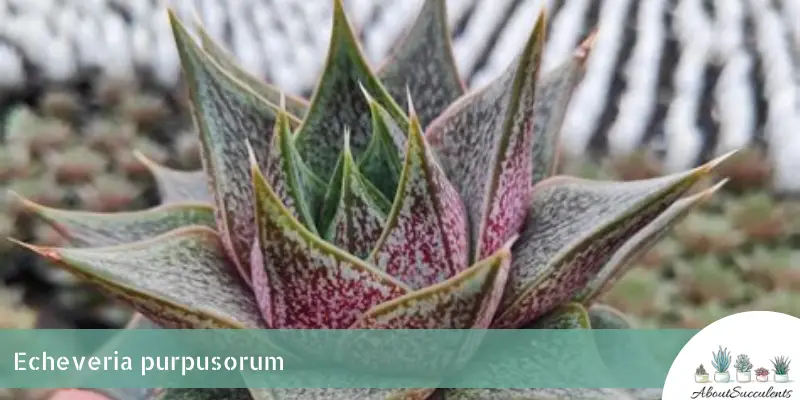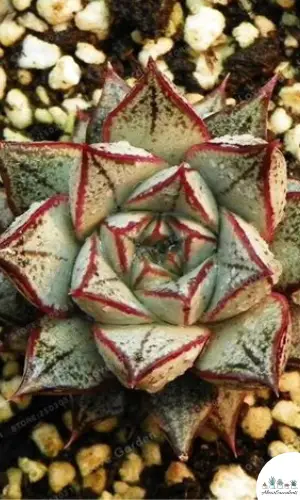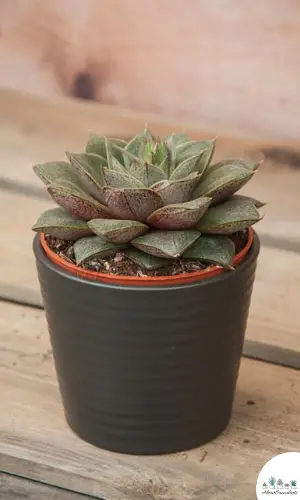
Echeveria purpusorum is a small, slow-growing succulent plant that has grown in popularity with hobbyists because of its otherworldly appearance that has been described as “reptilian”.
Also known as Urbinia, this succulent’s leaves have a triangular shape that’s uniquely identifiable with having sharp edges, spear-like tips, and speckled with reddish-brown dots that grow deep in color when regularly exposed to sunlight. The color of the leaves vary from light green to deep olive green.
A fully mature Echeveria purpusorum can reach a height and width of 15cm (6”). The leaves have a length of 3.81cm (1.5”) and a width of 2.54cm (1”).
As a slow-growing succulent, Urbinia hardly grows flowers. But if it does, you will be greeted with bright-red flowers with yellow tips in the springtime.
Echeveria purpusorum is native to Oaxaca, Mexico, and is a member of the Crassulaceae family.
General Information:
Also known as: Urbinia
Plant Family: Crassulaceae
Origin: Oaxaca, Mexico
Height: 15cm (6”)
Exposure: Full to partial sun of up to 6 hours
Water Needs: Typical watering needs; give the soil a thorough soaking when it’s completely dry.
Soil Type: Well-draining or cactus mix with pumice, perlite, or sand to improve the level of drainage.
Soil pH: 5.6 to 6.5
How to Grow and Care for Echeveria Purpusorum
Its peculiar appearance will certainly trigger curiosity among your guests which is why Echeveria purpusorum is well-received at weddings and family gatherings. It’s almost a standard feature for a succulent garland or wreath.
Growing Urbinia can be easy and trouble-free. If you follow our care tips below, you will have many wonderful days with Echeveria purpusorum to look forward to.
Sunlight
Echeveria purpusorum grows better when it receives partial to full sunlight. If you prefer this type of succulent as part of your outdoor garden, make sure it’s planted in an area that gets 6 hours or partial to direct morning sunlight.
To be sure, if your region experiences warmer temperatures and hotter morning sun, it would be best to give Urbinia partial exposure as the leaves can burn.
You can also grow the succulent plant indoors. This would be the ideal situation if the temperature of your region can drop below -6.7° C (20° F).
As an indoor succulent, place it near a window that receives 4 to 6 hours of sunlight per day. If getting regular sunlight is an issue in your region, you can put Urbinia under a Grow Light.
Watering

Echeveria purpusorum is a low maintenance succulent and doesn’t need as much water as other plants. In fact, giving it more water than it needs can lead to Urbinia’s demise.
Before watering, insert a stick into the soil. Pull out the stick and assess its level of dryness. If you’re 100% convinced that the soil is bone dry, give it a thorough soaking.
Echeveria purpusorum will need more water in the summer months because the soil will dry out faster. Conversely, the soil will require less water in the wintertime because the soil will hold on to moisture much longer.
Pot and Soil
Growing Echeveria purpusorum in a pot is a great idea if your region experiences temperature drops. This way, you can easily move the succulent from the outdoors to inside your home.
When choosing a pot, always consider either ceramic or terracotta as these types of materials will guarantee evaporation of moisture from the soil. If you buy Urbinia from a garden store, chances are it will be kept in a plastic pot.
Re-pot the succulent right away and make sure the pot that you buy has a drain hole at the bottom with a mesh cover. Place a drain tray underneath the pot to catch the excess water.
You can create your own soil mix for Echeveria purpusorum. You only need well-draining soil such as cactus mix and add ingredients such as perlite, pumice, and sand to improve drainage.
How to Propagate Echeveria Purpusorum

Propagating Echeveria purpusorum can be made possible with 3 methods: Leaf cuttings, seeds, or offsets.
Method 1: Leaf Cuttings
Step 1: Choose a healthy leaf from the stem and perform a clean twist and pull. To ensure a successful propagation of Urbinia, no part of the leaf must be left on the stem. You can also cut the leaf off by using a pair of sterilized and sharpened garden scissors.
Step 2: Allow the leaf cuttings to dry and develop calluses by leaving them in a warm area for 2 to 3 days.
Step 3: Place the hardened leaf cuttings on top of well-draining soil.
Step 4: Wait for the cuttings to develop roots before watering the soil. From there, water the soil only when it has gone dry.
Method 2: Seeds
Step 1: Plant the seeds in well-draining soil that has been pre-moistened.
Step 2: Cover the soil with a plastic wrap or a humidity dome and place the pot near an area that receives partial sunlight in order to encourage germination.
Step 3: Remove the humidity dome or the plastic when you see seedlings appear on the soil.
Step 4: The seedlings need more water than a fully-grown succulent. Lightly mist the soil with water every day for the first few weeks until you notice that the seedlings have taken firm root.
Step 5: Water the soil only when it feels dry to the touch.
Method 3: Offsets
Step 1: When properly cared for, Urbinia will produce offsets at the base of the plant. Choose an offset that has grown nearest to the plant to ensure the preservation of its roots.
Step 2: Gently cut off the offsets from the base of the mother plant with a pair of sharpened and sterilized garden scissors. You can also try to pull them out in a slow and gentle manner.
Step 3: Leave the offsets in a warm and dry place for 2 to 3 days so they can develop hard calluses.
Step 4: Plant the offsets in well-draining soil and water only if it has gone dry.
Frequently Asked Questions
Is Echeveria Purpusorum Toxic to Cats and Dogs?
Echeveria purpusorum cannot be found on the list of toxic plants on the website of the American Society for the Prevention of Cruelty to Animals (ASPCA).
The list on the website is only partial and there have been findings that Urbinia can be toxic to animals.
To be sure, keep your pets away from the plant. If you suspect that your pet has ingested a part of the succulent, bring the animal to the veterinarian as soon as possible.
Why Is My Echeveria Purpusorum Dying?
Overwatering and pest infestation are the 2 prime suspects if your Echeveria purpusorum has grown weaker or shown signs of dying.
Overwatering
The roots of a succulent plant cannot be immersed in moist conditions for a long period of time. If you give Urbinia more water than it needs, the roots will begin to rot and this will lead to infection.
Discoloration of the leaves and stems is the first sign of a fungal infection spreading. When you see a leaf turning dark or blackish-yellow, cut it off right away with a sterilized knife or a pair of garden shears.
Remove the succulent plant from the pot and shake off the excess soil so you can spot the roots that have rotted away. Cut off the infected roots and allow Echeveria purpusorum to dry.
Fill out a new ceramic or terracotta pot with well-draining soil then replant Echeveria purpusorum.
Pest Infestation
Fungus gnats, mealybugs, spider mites, and scale insects are attracted to the sap found in the leaves of Urbinia. Losing its sap will drain the succulent plant of vital nutrients and make it susceptible to a fungal infection.
Spray the plant with neem oil to keep these pests away. If you see white substances that appear like cotton balls on your leaves, these are clear signs the succulent is harboring spider mites or mealybugs. Wipe the leaves with insecticide soap or 70% isopropyl alcohol.
Does Echeveria Purpusorum Produce Flowers?
As a slow-growing succulent, Echeveria purpusorum rarely grows flowers. If well-taken care of, it will reward you with bright red flowers with yellow tips in the spring.
Last Updated on June 9, 2022 by Sofia Lara